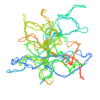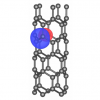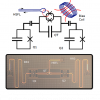Every month we feature an addition to our software library. What is a software module? answer here.

EESSI-based GitHub Action for Continuous Integration
Description This module sets up the European Environment for Scientific Software Installations (EESSI) for use in GitHub Workflows. The European Environment for Scientific Software Installations (EESSI) is a collaboration […]Read More »
March Module of the Month: DL_MESO (DPD) on Kokkos for enhanced performance portability
This work relates to the implementation of a performance portable version of DL_MESO (DPD) using the Kokkos library. It focuses on porting to DL_MESO (DPD) the first and second loops […]Read More »
March Module of the Month: n2p2 – Improved link to HPC MD software
This module improves the connection of n2p2 to HPC software, in particular to LAMMPS, by creating a pull request to the official LAMMPS repository. Furthermore, the build process for […]Read More »
February Module of the Month: ALL library implementation in HemeLB, a CoE collaboration
This module describes the work done in E-CAM in cooperation with the HemeLB code from the CompBioMed Centre of Excellence. HemeLB is a high performance lattice-Boltzmann solver optimised for […]Read More »
January Module of the Month: MaZe, Mass-Zero Constrained Dynamics for Orbital Free Density Functional Theory
Description The program performs Orbital-Free Density Functional Theory Molecular Dynamics (OF-DFT-MD) using the Mass-Zero (MaZe) constrained molecular dynamics approach described in [1]. This method enforces, at each time step, the […]Read More »
December Module of the Month: Load balancing for multi-GPU DL_MESO
Description This module concerns the implementation of the E-CAM Load Balancing Library (ALL) in the multi-GPU version of DL_MESO_DPD code. The intention is to allow for better performance when […]Read More »
November Module of the Month: PerGauss, Periodic Boundary Conditions for gaussian bases
Description The module PerGauss (Per iodic Gauss ians) consists on an implementation of periodic boundary conditions for gaussian bases for the Quantics program package. In quantum dynamics, the choice of coordinates is crucial to […]Read More »
Dask-traj
For analysis of molecular dynamics (MD) simulations MDTraj is a fast and commonly used analysis. However MDTraj has some restrictions such as (1) the whole trajectory needs to fit into memory, […]Read More »
CLstunfti: An extendable Python toolbox to compute scattering of electrons with a given kinetic energy in liquids and amorphous solids
Description CLstunfti is an extendable Python toolbox to compute scattering of electrons with a given kinetic energy in liquids and amorphous solids. It uses a continuum trajectory model with […]Read More »
Minimal distance segment to segment with Karush-Kuhn-Tucker conditions
Description The module minDist2segments_KKT returns the minimal distance between two line segments. It uses the Karush-Kuhn-Tucker conditions (KKT) for the minimization under constraints. Practical application We use the present module to avoid […]Read More »
E-CAM High Throughput Computing Library
This module is the first in a sequence that will form the overall capabilities of the E-CAM High Throughout Computing (HTC) library. In particular this module deals with creating a […]Read More »
Automated high-throughput Wannierisation, a successful collaboration between E-CAM and the MaX Centre of Excellence
Maximally-localised Wannier functions (MLWFs) are routinely used to compute from first- principles advanced materials properties that require very dense Brillouin zone (BZ) integration and to build accurate tight-binding models for […]Read More »
QMCPack Interfaces for Electronic Structure Computations
Quantum Monte Carlo (QMC) methods are a class of ab initio, stochastic techniques for the study of quantum systems. While QMC simulations are computationally expensive, they have the advantage of […]Read More »
PANNA: Properties from Artificial Neural Network Architectures
PANNA is a package for training and validating neural networks to represent atomic potentials. It implements configurable all-to-all connected deep neural network architectures which allow for the exploration of training […]Read More »
Pyscal- A python module for structural analysis of atomic environments
Description pyscal is a python module for the calculation of local atomic structural environments including Steinhardt’s bond orientational order parameters[1] during post-processing of atomistic simulation data. The core functionality of pyscal is […]Read More »
Multi-GPU version of DL_MESO_DPD
This module implements the first version of the DL_MESO_DPD Mesoscale Simulation Package, with multiple NVidia Graphical Processing Units (GPUs). In this module the main framework of a multi-GPU version of […]Read More »
Integrating LAMMPS with OpenPathSampling
This module shows how LAMMPS can be used as Molecular Dynamic (MD) engine in OpenPathSampling (OPS) and it also provide a benchmark for the impact of OPS overhead over the […]Read More »
FFTXlib, a rewrite and optimisation of earlier versions of FFT related routines inside QE pre-v6
FFTXlib is mainly a rewrite and optimisation of earlier versions of FFT related routines inside Quantum ESPRESSO (QE) pre-v6; and finally their replacement. Despite many similarities, current version of FFTXlib […]Read More »
Extension of the ParaDiS code to include precipitate interactions, and code optimisation to run on HPC environment
Here present two featured software modules of the month: ParaDiS with precipitates ParaDiS with precipitates optimized to HPC environment that provide extensions to the ParaDIS Discrete dislocation dynamics (DDD) code […]Read More »DBCSR@MatrixSwitch, an optimised library to deal with sparse matrices
MatrixSwitch is a module which acts as an intermediary interface layer between high-level and low-level routines dealing with matrix storage and manipulation. It allows a seamlessly switch between different software implementations […]Read More »
Abrupt GC-AdResS: A new and more general implementation of the Grand Canonical Adaptive Resolution Scheme (GC-AdResS)
The Grand Canonical Adaptive resolution scheme (GC-AdResS) gives a methodological description to partition a simulation box into different regions with different degrees of accuracy. For more details on the theory […]Read More »
Porting of electrostatics to the GPU version of DL_MESO_DPD
The porting of DL_MESO_DPD [1,2] to graphic cards (GPUs) was reported in deliverable D4.2 of E-CAM[3] (for a single GPU) and deliverable D4.3 [4] (for multiple GPUs) (Figure 1), and […]Read More »
CTMQC, a module for excited-state nonadiabatic dynamics
CTMQC is a module for excited-state nonadiabatic dynamics. It is used to simulate the coupled dynamics of electrons and nuclei (ideally in gas phase molecular systems) in response to, […]Read More »
SCDM_WFs
Module SCDM_WFs implements the selected columns of the density matrix (SCDM) method [1] for building localized Wannier Functions (WFs). Wannier90 [2] is a post-processing tool for the computation of the Maximally Localised Wannier […]Read More »
QQ-Interface (Quantics-QChem-Interface)
The QQ-Interface module connects the full quantum nonadiabatic wavefunction propagation code Quantics to the time-dependent density functional theory (TDDFT) module of the electronic structure program Q-Chem. Q-Chem provides analytic gradients, Hessians and […]Read More »
PLUMED wrapper for OpenPathSampling
PLUMED is a widely used and versatile rare-event sampling and analysis code that can be used with various Molecular Dynamics (MD) engines. It has a very intuitive and versatile […]Read More »
Improving I/O of DL_MESO_DPD files using SIONlib
This module implements the SIONlib library to optimize the I/O (writing/reading) of the trajectory files generated by DL_MESO_DPD, the Dissipative Particle Dynamics (DPD) code from the DL_MESO package. SIONlib […]Read More »
PaPIM: A code for Quantum Time Correlation Functions
PaPIM code is a package to study the (quantum) properties of materials, and in particular time correlation functions, via the so-called mixed quantum-classical methods. In these schemes, quantum evolution […]Read More »
Spring shooting – A module for improving efficiency of transition path sampling
Transition path sampling is most efficient when paths are generated from the top of the free energy barrier. However, complex (biomolecular) activated processes, such as nucleation or protein binding/unbinding, […]Read More »
Symmetry Adapted Wannier Functions – a Component of the Wannier90
Symmetry Adapted Wannier Functions is a module within Wannier90 which is devoted to the construction of Wannier function (WF) with a given symmetry. The procedure implemented in this module […]Read More »
PIM_wd: Module for sampling of the quantum Wigner distribution
The PIM_wd module implements the exact quantum Wigner probability distribution function sampling algorithm of the Phase Integration Method [1], and is the main subroutine for the quantum correlation function […]Read More »
Coarse-Graining module, a Component of the Hierarchical Equilibration Strategy for Polymer Melts
To study the properties of polymer melts by numerical simulations, equilibrated configurations must be prepared. However, the relaxation time for high molecular weight polymer melts is huge and increases, according […]Read More »
Contact Map – a package for analyzing and exploring contacts, from a trajectory generated by MD
Contacts can be an important tool for defining (meta)stable states in processes involving biomolecules. For example, an analysis of contacts can be particularly useful when defining bound states during […]Read More »
LocConQubit, a module for the construction of controlled pulses on isolated qubit systems using the Local Control Theory
The LocConQubit module implements the Local Control Theory[1,2], an algorithm for on-the-fly construction of a time-dependent potential that drives the evolution of a Hamiltonian towards one of its eigenstates. […]Read More »
GRASP Sampling – a module to build a representative data set for a fitting procedure
GRASP_sampling performs a stratified sampling of the configurations, described by vectors, of a system to build a representative training set in a fitting procedure. Given a list of candidate configurations, […]Read More »Geomoltools: A set of software modules to easily manipulate molecular geometries
Geomoltools is a set of eight pre- and post-treatment Fortran codes that can be used to easily manipulate molecular geometries, allowing to minimize the average energy obtained for a range […]Read More »Path density for OpenPathSampling
Module path density implements path density calculations for the OpenPathSampling (OPS) package, including a generic multidimensional sparse histogram, and plotting functions for the two-dimensional case. Path density plots provide a […]Read More »Second-Order Differencing Scheme
This module, SodLib, provides exact wavefunction propagation using the second-order differencing (SOD) integrator scheme to solve the time-dependent Schrödinger equation as described by Leforestier et al, J. Comp Phys, 94, […]Read More »First GPU version of the DL_MESO_DPD code
DL_MESO_DPD, is the Dissipative Particle Dynamics (DPD) code from the mesoscopic simulation package DL_MESO [1], developed by Dr. Michael Seaton at Daresbury Laboratory (UK). This open source code is available […]Read More »LibOMM : Orbital Minimization Method Library
Purpose The library LibOMM solves the Kohn-Sham equation as a generalized eigenvalue problem for a fixed Hamiltonian. It implements the orbital minimization method (OMM), which works within a density matrix […]Read More »Analysis of charge dipole moments in DL_MESO_DPD
The present module, gen_dipole.f90, is a generalization of the dipole.f90 post-processing utility of DL_MESO_DPD, the Dissipative Particle Dynamics (DPD) code from the DL_MESO package. It processes the trajectory (HISTORY) files […]Read More »Solvers for quantum atomic radial equations
SQARE (solvers for quantum atomic radial equations) is a library of utilities intended for dealing with functions discretized on radial meshes, wave-equations with spherical symmetry and their corresponding quantum states. […]Read More »ClassMC
Module ClassMC samples the system phase space using the classical Boltzmann distribution function and calculates the time correlation functions from the sampled initial conditions. For more information check the module […]Read More »Direct MD (on-the-fly) flux/rate in OpenPathSampling
This module, based on OpenPathSampling, calculates the flux out of a state and through an interface, or the rate of the transition between two states, while running a trajectory. For […]Read More »
